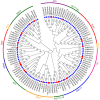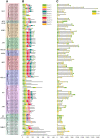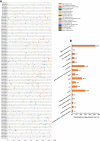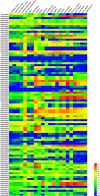MIKC-type MADS-box transcription factor gene family in peanut: Genome-wide characterization and expression analysis under abiotic stress
- PMID: 36340369
- PMCID: PMC9631947
- DOI: 10.3389/fpls.2022.980933
MIKC-type MADS-box transcription factor gene family in peanut: Genome-wide characterization and expression analysis under abiotic stress
Abstract
Peanut (Arachis hypogaea) is one of the most important economic crops around the world, especially since it provides vegetable oil and high-quality protein for humans. Proteins encoded by MADS-box transcription factors are widely involved in regulating plant growth and development as well as responses to abiotic stresses. However, the MIKC-type MADS-box TFs in peanut remains currently unclear. Hence, in this study, 166 MIKC-type MADS-box genes were identified in both cultivated and wild-type peanut genomes, which were divided into 12 subfamilies. We found a variety of development-, hormone-, and stress-related cis-acting elements in the promoter region of peanut MIKC-type MADS-box genes. The chromosomal distribution of peanut MADS-box genes was not random, and gene duplication contributed to the expansion of the MADS-box gene family. The interaction network of the peanut AhMADS proteins was established. Expression pattern analysis showed that AhMADS genes were specifically expressed in tissues and under abiotic stresses. It was further confirmed via the qRT-PCR technique that five selected AhMADS genes could be induced by abiotic and hormone treatments and presented different expressive profiles under various stresses. Taken together, these findings provide valuable information for the exploration of candidate genes in molecular breeding and further study of AhMADS gene functions.
Keywords: MADS-box transcription factor; abiotic stress; expression patterns; peanut; phylogenetic analysis.
Copyright © 2022 Mou, Yuan, Sun, Yan, Zhao, Wang, Wang, Shan and Li.
Conflict of interest statement
The authors declare that the research was conducted in the absence of any commercial or financial relationships that could be construed as a potential conflict of interest.
Figures










Similar articles
-
Genome-Wide Identification MIKC-Type MADS-Box Gene Family and Their Roles during Development of Floral Buds in Wheel Wingnut (Cyclocarya paliurus).Int J Mol Sci. 2021 Sep 19;22(18):10128. doi: 10.3390/ijms221810128. Int J Mol Sci. 2021. PMID: 34576289 Free PMC article.
-
Genome-wide identification of the MADS-box transcription factor family in autotetraploid cultivated alfalfa (Medicago sativa L.) and expression analysis under abiotic stress.BMC Genomics. 2021 Aug 7;22(1):603. doi: 10.1186/s12864-021-07911-9. BMC Genomics. 2021. PMID: 34362293 Free PMC article.
-
Genome-wide identification and analysis of MIKC-type MADS-box genes expression in Chimonanthus salicifolius.Genes Genomics. 2023 Sep;45(9):1127-1141. doi: 10.1007/s13258-023-01420-7. Epub 2023 Jul 12. Genes Genomics. 2023. PMID: 37438657
-
Genome-wide Analysis of the MADS-Box Gene Family in Watermelon.Comput Biol Chem. 2019 Jun;80:341-350. doi: 10.1016/j.compbiolchem.2019.04.013. Epub 2019 May 2. Comput Biol Chem. 2019. PMID: 31082717 Review.
-
The major clades of MADS-box genes and their role in the development and evolution of flowering plants.Mol Phylogenet Evol. 2003 Dec;29(3):464-89. doi: 10.1016/s1055-7903(03)00207-0. Mol Phylogenet Evol. 2003. PMID: 14615187 Review.
Cited by
-
Genome-wide characterization and expression analysis of MADS-box transcription factor gene family in Perilla frutescens.Front Plant Sci. 2024 Jan 8;14:1299902. doi: 10.3389/fpls.2023.1299902. eCollection 2023. Front Plant Sci. 2024. PMID: 38259943 Free PMC article.
-
Genome-Wide Identification of Peanut B-Boxs and Functional Characterization of AhBBX6 in Salt and Drought Stresses.Plants (Basel). 2024 Mar 26;13(7):955. doi: 10.3390/plants13070955. Plants (Basel). 2024. PMID: 38611484 Free PMC article.
-
Transcriptome sequencing and screening of genes related to the MADS-box gene family in Clematis courtoisii.PLoS One. 2024 Feb 5;19(2):e0294426. doi: 10.1371/journal.pone.0294426. eCollection 2024. PLoS One. 2024. PMID: 38315679 Free PMC article.
-
Nematode-resistance loci in upland cotton genomes are associated with structural differences.G3 (Bethesda). 2024 Sep 4;14(9):jkae140. doi: 10.1093/g3journal/jkae140. G3 (Bethesda). 2024. PMID: 38934790 Free PMC article.
-
Ectopic Expression of MADS-Box Transcription Factor VvAGL12 from Grape Promotes Early Flowering, Plant Growth, and Production by Regulating Cell-Wall Architecture in Arabidopsis.Genes (Basel). 2023 Nov 15;14(11):2078. doi: 10.3390/genes14112078. Genes (Basel). 2023. PMID: 38003021 Free PMC article.
References
-
- Alvarez-Buylla E. R., Pelaz S., Liljegren S. J., Gold S. E., Burge Ff C., Ditta G. S., et al. . (2000). An ancestral MADS-box gene duplication occurred before the divergence of plants and animals. Proc. Natl. Acad. Sci. United States America 97 (10), 5328–5333. doi: 10.1073/pnas.97.10.5328 - DOI - PMC - PubMed
LinkOut - more resources
Full Text Sources

